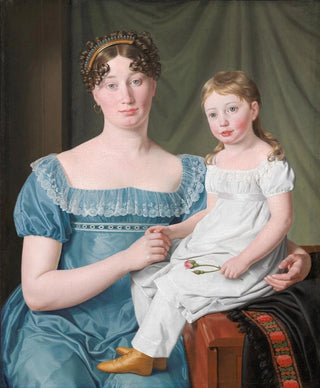Art print | Portrait of a noble woman Sophie Hedvig Løvenskiold and her three-year-old daughter - Christoffer Wilhelm Eckersberg


View from behind

Frame (optional)
In the vast panorama of art history, some works manage to capture not only the essence of a period but also the intimacy of family bonds. The "Art print of a noble woman Sophie Hedvig Løvenskiold and her three-year-old daughter" by Christoffer Wilhelm Eckersberg perfectly fits into this tradition. This moving painting does not merely depict two female figures; it also evokes the values and aspirations of a 19th-century Danish society. Through this portrait, the viewer is invited to delve into the delicate universe of Scandinavian nobility, where elegance and tenderness blend harmoniously.
Style and uniqueness of the work
The work stands out for its carefully orchestrated composition, where the mother and her daughter are at the center of an refined setting. Eckersberg, master of realism, uses a palette of soft colors that confer a serene and calming atmosphere to the scene. The meticulous details of the clothing, as well as the expressions of the characters, testify to attentive observation of daily life and human emotions. The light, subtly balanced, highlights the faces and creates a play of shadow and light that emphasizes the depth of the painting. This stylistic choice makes the emotional bond between Sophie Hedvig and her daughter palpable, while also highlighting their high social status. This portrait, beyond its decorative function, thus becomes a living testimony of family relationships and social conventions of the time.
The artist and his influence
Christoffer Wilhelm Eckersberg, often considered the father of modern Danish painting, knew how to marry tradition and innovation throughout his career. Trained at the Royal Danish Academy of Fine Arts in Copenhagen, he was influenced by the great European masters, while developing a style unique to himself. His ability to capture light and textures made him a pioneer of realism, and his works continue to inspire many contemporary artists. Eckersberg also played a crucial role in artistic education in Denmark, shaping a new generation of painters who would

Matte finish

View from behind

Frame (optional)
In the vast panorama of art history, some works manage to capture not only the essence of a period but also the intimacy of family bonds. The "Art print of a noble woman Sophie Hedvig Løvenskiold and her three-year-old daughter" by Christoffer Wilhelm Eckersberg perfectly fits into this tradition. This moving painting does not merely depict two female figures; it also evokes the values and aspirations of a 19th-century Danish society. Through this portrait, the viewer is invited to delve into the delicate universe of Scandinavian nobility, where elegance and tenderness blend harmoniously.
Style and uniqueness of the work
The work stands out for its carefully orchestrated composition, where the mother and her daughter are at the center of an refined setting. Eckersberg, master of realism, uses a palette of soft colors that confer a serene and calming atmosphere to the scene. The meticulous details of the clothing, as well as the expressions of the characters, testify to attentive observation of daily life and human emotions. The light, subtly balanced, highlights the faces and creates a play of shadow and light that emphasizes the depth of the painting. This stylistic choice makes the emotional bond between Sophie Hedvig and her daughter palpable, while also highlighting their high social status. This portrait, beyond its decorative function, thus becomes a living testimony of family relationships and social conventions of the time.
The artist and his influence
Christoffer Wilhelm Eckersberg, often considered the father of modern Danish painting, knew how to marry tradition and innovation throughout his career. Trained at the Royal Danish Academy of Fine Arts in Copenhagen, he was influenced by the great European masters, while developing a style unique to himself. His ability to capture light and textures made him a pioneer of realism, and his works continue to inspire many contemporary artists. Eckersberg also played a crucial role in artistic education in Denmark, shaping a new generation of painters who would






